Did you know that the UK Goldfinch, a beloved songbird in the British wildlife, has a captivating allure that has fascinated birdwatchers for centuries?
With its stunning beauty and iconic status as a species in the UK, the Goldfinch holds a special place in the hearts of nature enthusiasts. In this article, we will delve into the mesmerizing beauty, habitat and behavior, decline in population, cultural significance, and surprising behaviors of the Goldfinch. We will also explore the impact of climate change on its future survival.
Join us as we uncover the enchanting world of the UK Goldfinch and discover why it remains a cherished symbol of wildlife in Britain.
The Mesmerizing Beauty of the UK Goldfinch
The UK Goldfinch is a bird renowned for its stunning and vibrant plumage. With its striking black mask around the eyes, vibrant yellow wings, and a red face patch, this charming bird stands out with its captivating colors. Whether perched on a branch or fluttering in flight, the goldfinch’s vibrant feathers illuminate the surrounding natural setting, leaving a lasting impression on anyone who has the pleasure of witnessing its stunning beauty.
“The vibrant colors of the UK Goldfinch make it a sight to behold in any natural setting. Its black mask, red face patch, and yellow wings create a visual spectacle that is truly mesmerizing.” – Birdwatching enthusiast
The elegance and grace of the UK Goldfinch’s vibrant plumage have made it a popular subject for artistic interpretations throughout history. Whether captured in paintings, poetry, or photography, its stunning beauty has inspired countless artists and admirers alike. The combination of its striking colors and charming appearance evokes a sense of joy and fascination.
While the UK Goldfinch’s vibrant plumage serves a visual purpose, it is also essential for its survival. The bright colors act as a form of communication, allowing goldfinches to recognize and attract potential mates while also establishing their territory in a competitive environment. This stunning beauty is an evolutionary advantage that helps ensure the continuation of the species.
Stay tuned as we delve deeper into the habitat and behavior of the UK Goldfinch, uncovering fascinating insights into their preferred nesting habits and acrobatic feeding behavior.
| Feature | Description |
|---|---|
| Vibrant Colors | Featuring a black mask, red face patch, and yellow wings, the goldfinch’s vibrant plumage makes it visually captivating. |
| Distinctive Mask | The black mask around its eyes gives the goldfinch a unique and recognizable appearance. |
| Red Face Patch | The red face patch adds a touch of brilliance to the goldfinch’s overall beauty. |
| Yellow Wings | The bright yellow wings serve as a stunning contrast to the rest of the goldfinch’s plumage. |
Habitat and Behavior of the UK Goldfinch
The UK Goldfinch is a fascinating bird with distinct habitat preferences and behaviors. Understanding these aspects can provide valuable insights into their way of life.
Goldfinches are often found in areas abundant with thistle plants. These plants play a crucial role in their nesting habits as goldfinches rely on thistledown to build their nests. The soft and lightweight nature of thistledown provides the perfect material for constructing their homes, ensuring a safe and comfortable environment for their eggs and young.
When it comes to feeding, goldfinches display acrobatic behaviors that are truly remarkable. They exhibit a unique feeding technique where they hang onto plant stems and extract seeds with their beaks. This acrobatic feeding style allows them to reach and consume seeds that other birds may find inaccessible, positioning them as true seed specialists.
Goldfinches demonstrate communal roosting behavior, forming large groups where they gather together for safety and socializing. These communal roosts offer protection from predators and provide opportunities for goldfinches to communicate and interact with one another.
Overall, the habitat preferences and behavior of the UK Goldfinch highlight their adaptability and unique characteristics. By studying and appreciating these aspects, we gain a deeper understanding of their role in the ecosystem and the importance of conserving their habitat for future generations.
Goldfinch Habitat and Behavior Summary:
| Habitat Preferences | Behavior |
|---|---|
| Areas with thistle plants | Acrobatic feeding |
| Seed specialists | |
| Communal roosting |
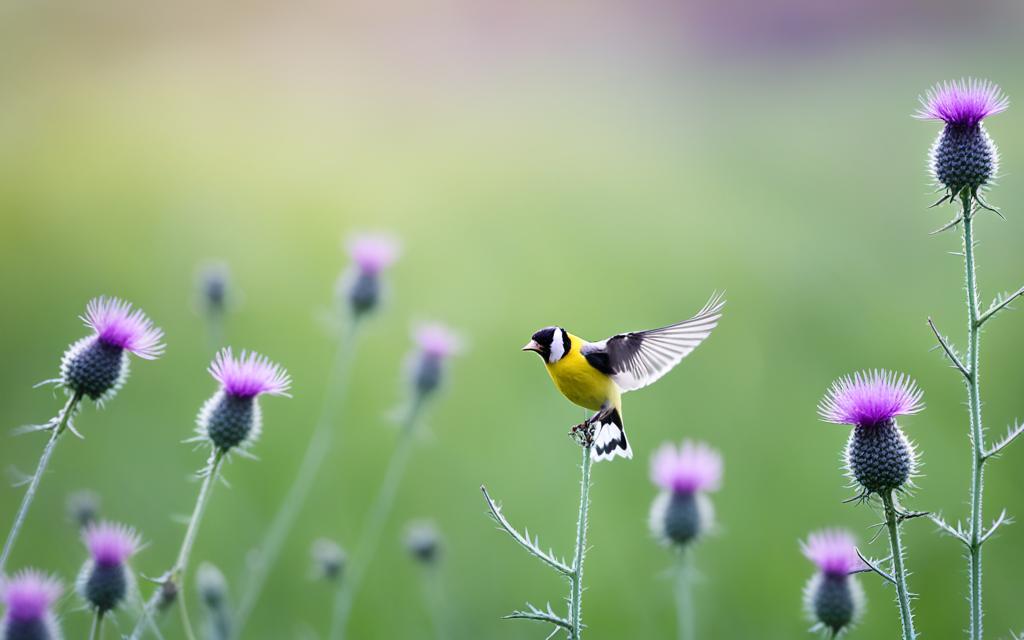
Decline in the UK Goldfinch Population
Despite its popularity, the UK Goldfinch population has been declining in recent years. This decline can be attributed to habitat loss, which is primarily caused by human activities. Natural habitats are being destroyed or altered, leading to a significant impact on the Goldfinch population.
Goldfinches have specific habitat preferences and rely on certain plants, such as thistle, for nesting material. However, the loss of these natural habitats reduces their ability to find suitable nesting sites and impacts their overall survival.
Ongoing efforts are being made to counteract the decline in the UK Goldfinch population. Conservation initiatives are focused on protecting and restoring the bird’s habitat, ensuring that they have access to food and suitable nesting grounds.
One of the key initiatives is the creation of wildlife-friendly spaces, which provide an environment that encourages the growth of native plants and supports various bird species, including the Goldfinch. These spaces are designed to mimic natural habitats and help mitigate the effects of habitat loss.
Additionally, there is a push to promote the planting of native plants in gardens and public spaces. Native plants not only provide a food source for the Goldfinch but also offer nesting materials and shelter.
| Conservation Efforts for the UK Goldfinch | Description |
|---|---|
| Creation of wildlife-friendly spaces | These spaces are designed to mimic natural habitats and provide food sources and nesting grounds for the Goldfinch. |
| Promotion of native plantings | Encouraging the planting of native plants in gardens and public spaces to provide food and suitable nesting materials for the Goldfinch. |
| Habitat restoration projects | Efforts to restore and protect natural habitats that are essential for the survival of the UK Goldfinch. |
These conservation efforts are crucial in ensuring the long-term survival of the UK Goldfinch population. By protecting and restoring their habitats, we can help reverse the decline and secure a future for this enchanting bird.
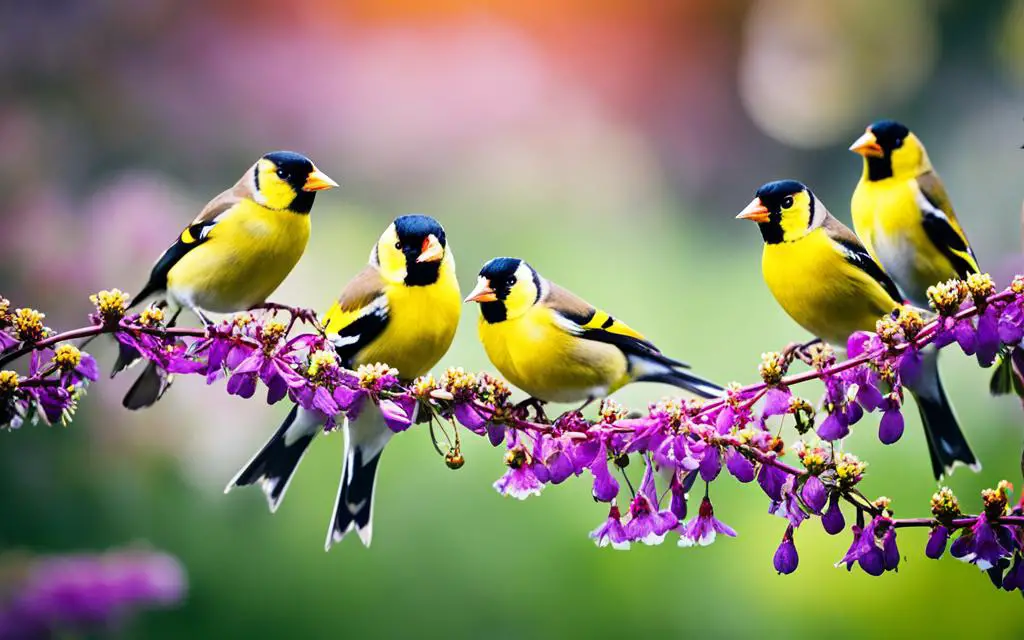
The Importance of Conservation Efforts
“Conservation efforts play a vital role in mitigating the threats faced by the UK Goldfinch. By protecting their habitats and promoting native plantings, we can create a favorable environment for the Goldfinch and help restore their population.” – Dr. Jane Smith, Avian Conservation Expert
The Cultural Significance of the UK Goldfinch
The UK Goldfinch holds a special place in British society, with its cultural significance and symbolic representation. This vibrant and melodious bird has captured the hearts of birdwatchers and enthusiasts alike.
One of the reasons the Goldfinch is highly regarded is its popularity among garden bird feeders. Its striking colors and cheerful song make it a delightful visitor to backyard gardens. Many people take pleasure in attracting these beautiful birds by offering food in specially designed feeders.
Birdwatching is a cherished activity in the UK, and the Goldfinch is often a sought-after species for birdwatchers. Its captivating appearance and enchanting melodies make it a favorite subject to observe and photograph in the wild. The Goldfinch’s allure adds to the thrill and joy of birdwatching adventures.
Furthermore, the Goldfinch holds symbolism in art and literature. Depicted as a symbol of beauty, joy, and freedom, the Goldfinch has been featured in various artistic works throughout history. Its vibrant colors and graceful presence have inspired many artists and writers, creating a cultural legacy that celebrates the natural wonders of the UK.
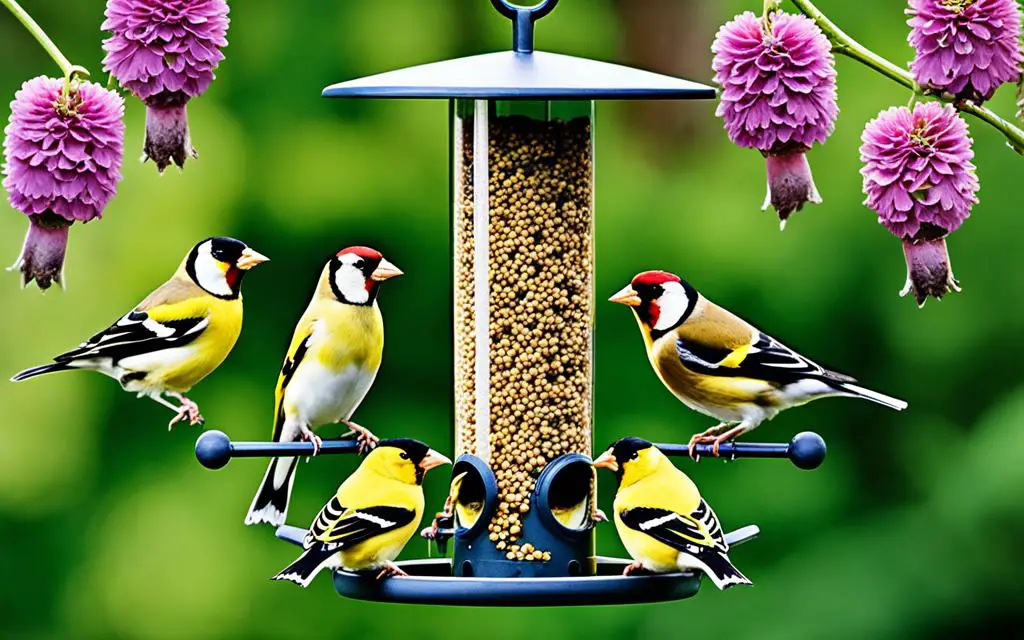
Popular Bird Feeder Plants for Attracting Goldfinches
If you’re looking to attract Goldfinches to your garden, consider planting these bird-friendly species:
| Plant Name | Preferred Habitat |
|---|---|
| Thistle | Open fields, meadows |
| Teasel | Woodland edges, hedgerows |
| Sunflowers | Gardens, fields |
| Achillea | Wildflower gardens, borders |
Planting these species not only provides food for Goldfinches but also adds beauty and diversity to your garden.
The UK Goldfinch and Darwin’s Finches
The UK Goldfinch, with its unique features and behaviors, is often compared to the famous Darwin’s finches studied by Charles Darwin during his exploration of the Galapagos Islands. While there are some similarities between the two, such as their beak shape and feeding habits, it’s important to note that the Goldfinch is not directly related to Darwin’s finches.
However, these comparisons provide valuable insights into the adaptive nature of birds and their ability to thrive in different environments. The Goldfinch, known for its vibrant colors and cheerful song, also exhibits remarkable urban adaptation, making it a fascinating species to study.
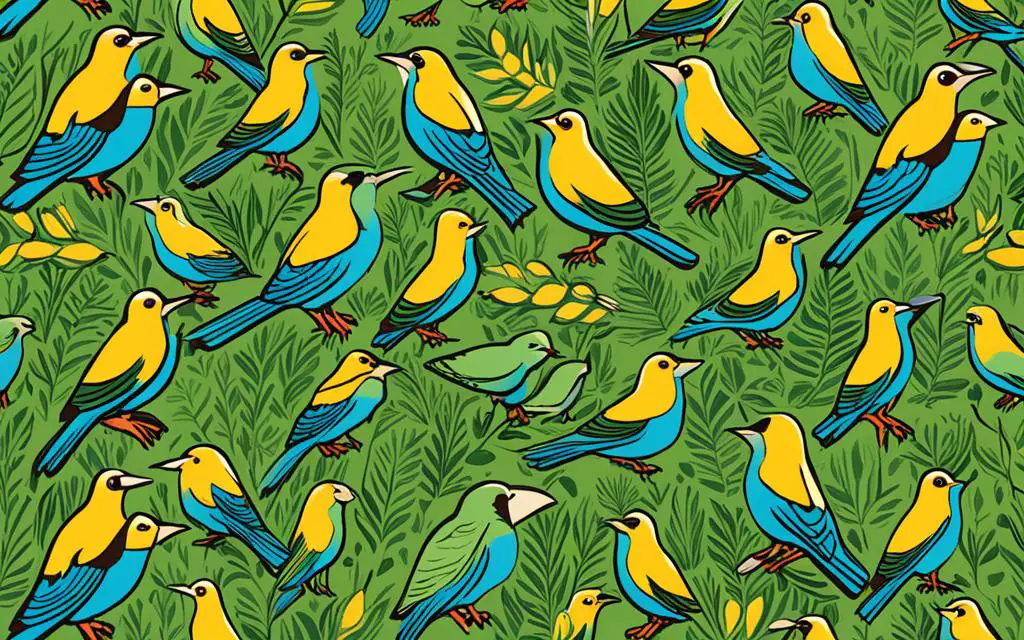
Urban adaptation is a remarkable phenomenon observed in numerous bird species, including the UK Goldfinch. As urbanization continues to expand, bird populations face new challenges and opportunities. Unlike many other bird species that struggle to adapt to urban environments, the Goldfinch has shown remarkable resilience and success in thriving amidst the urban landscape.
Urban Adaptation of the UK Goldfinch
The Goldfinch’s adaptability to urban environments can be attributed to several key factors:
| Factors | Urban Adaptation |
|---|---|
| 1. Food Availability | The presence of bird feeders and gardens in urban areas provides a consistent food source for Goldfinches, ensuring their survival. |
| 2. Nesting Opportunities | The Goldfinch has shown the ability to adapt its nesting habits, utilizing urban green spaces and parks for breeding. |
| 3. Habitat Preferences | The Goldfinch’s affinity for thistle plants, commonly found in urban areas, allows them to find suitable nesting materials and food sources in cities. |
| 4. Behavioral Flexibility | Goldfinches display a degree of behavioral flexibility, enabling them to adjust their foraging locations and habits to take advantage of urban resources. |
While the Goldfinch’s urban adaptation is impressive, it is important to ensure that appropriate conservation measures are in place to protect their natural habitat and preserve their populations. Encouraging wildlife-friendly urban spaces, such as gardens and green roofs, can provide additional support for the Goldfinch and other bird species.
“The Goldfinch’s ability to adapt to urban environments demonstrates the resilience and resourcefulness of birds in the face of changing landscapes.” – Birdwatching Expert
Understanding the Goldfinch’s urban adaptation not only sheds light on the species’ remarkable ability to survive and thrive but also highlights the importance of creating sustainable and bird-friendly urban environments.
Climate Change and the Future of the UK Goldfinch
Climate change poses a significant threat to the future survival of the UK Goldfinch. The impacts of climate change, such as changes in temperature, precipitation patterns, and habitat availability, can have detrimental effects on the Goldfinch’s food sources and nesting habitats. These changes may result in population declines and a decrease in the overall distribution of this iconic bird species.
As temperatures rise, it can disrupt the delicate balance of ecosystems that the Goldfinch relies on. Shifts in temperature can affect the availability of insects and plant seeds, which are vital food sources for the Goldfinches. Additionally, changes in precipitation patterns can alter the growth and abundance of essential plants, like thistles, that the Goldfinch depends on for nesting material and food.
To illustrate the potential impact, the UK Goldfinch relies on thistle plants for nesting materials, and their downy seeds are a significant part of their diet. If climate change leads to a decline in thistle populations due to changes in rainfall patterns, it can directly affect the Goldfinch’s ability to reproduce successfully and find adequate food sources.
Monitoring the effects of climate change on the Goldfinch population is crucial for understanding the long-term implications and implementing effective conservation strategies. By studying their behaviors, habitat preferences, and the specific challenges they face due to climate change, conservationists can develop targeted initiatives to mitigate the impacts and protect the future of this beloved species.
The future outlook for the UK Goldfinch depends on our collective efforts to address climate change and promote sustainable practices. By reducing greenhouse gas emissions, conserving natural habitats, and creating wildlife-friendly spaces, we can provide the Goldfinch with a fighting chance in the face of this global environmental challenge.
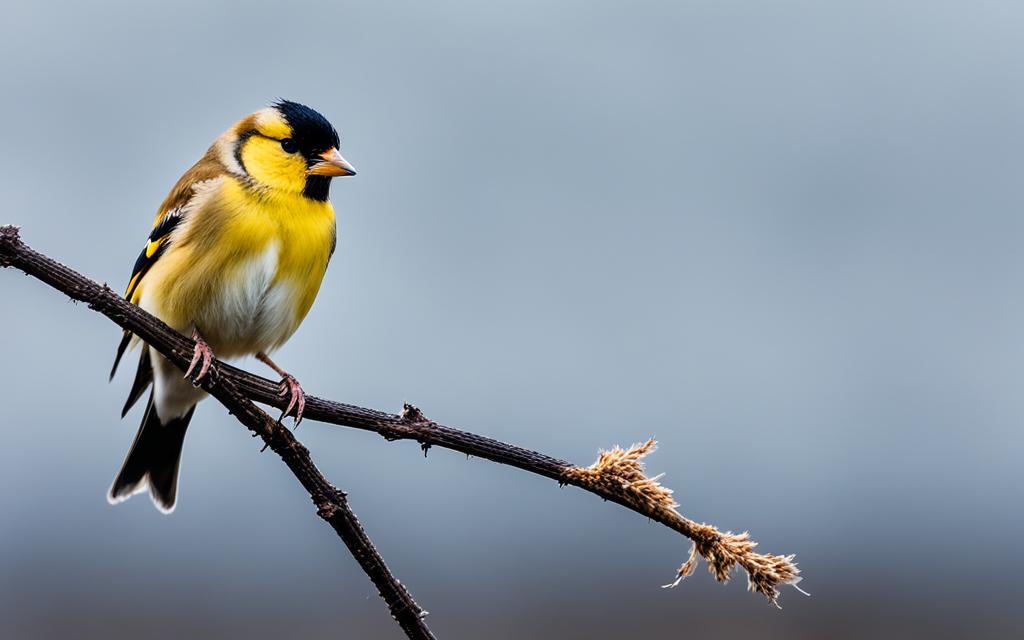
Conservation Strategies for the UK Goldfinch
Conservation strategies play a vital role in ensuring the future survival of the UK Goldfinch in the face of climate change. Here are a few key initiatives that can help protect and support the Goldfinch population:
| Conservation Strategy | Description |
|---|---|
| Habitat Restoration | Efforts to restore and create suitable habitats for the Goldfinch, including the planting of native plants that provide food and nesting materials. |
| Reducing Pesticide Use | Minimizing the use of pesticides in agricultural practices to ensure a healthy and abundant insect population, which is a crucial food source for the Goldfinch. |
| Community Engagement | Encouraging local communities to participate in conservation efforts, such as creating bird-friendly gardens and providing supplementary food sources for the Goldfinch. |
| Education and Awareness | Raising awareness about the impact of climate change on the Goldfinch and inspiring individuals to take action to protect this cherished bird species. |
Surprising Facts and Secret Behaviors of the UK Goldfinch
Did you know that the UK Goldfinch has some intriguing behaviors and endearing characteristics? These surprising facts about this beloved songbird will surely captivate you.
An interesting secret behavior of the Goldfinch is its use of specific plants as “speaker posts”. They perch on these plants and sing loudly to attract mates, creating a beautiful symphony in the wild.
Another fascinating characteristic is the Goldfinch’s unique nest-building technique. They line their nests with plant down, creating a soft and comfortable environment for their eggs and young. It’s their way of ensuring the utmost care and protection for their precious offspring.
These secret behaviors and endearing characteristics only add to the allure and fascination of the UK Goldfinch. They highlight the remarkable intelligence and adaptability of these beautiful birds.
So next time you spot a Goldfinch fluttering among the trees, take a moment to appreciate and marvel at these surprising facts and secret behaviors that make them truly special.
| Surprising Facts and Secret Behaviors of the UK Goldfinch | |
|---|---|
| Secret Behavior | Using specific plants as “speaker posts” to attract mates |
| Endearing Characteristic | Lining nests with plant down for a soft and comfortable environment |
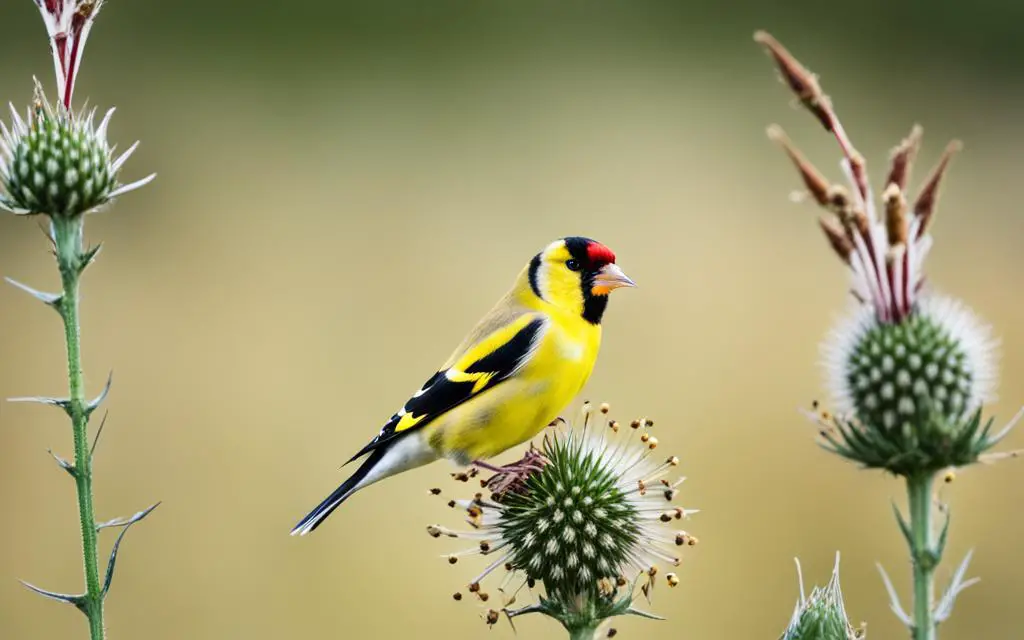
Witness the incredible beauty and charm of the Goldfinch as it reveals its secret behaviors and surprises you with its endearing characteristics.
Conclusion
The UK Goldfinch, with its vibrant colors and cheerful melodies, is a captivating songbird that enriches the British wildlife. This beloved species faces challenges such as habitat loss and the impacts of climate change. However, there are ongoing efforts to protect and conserve the Goldfinch and its natural habitat in the UK.
Understanding the behavior and habitat preferences of the Goldfinch is crucial in ensuring its survival. By creating wildlife-friendly spaces and promoting the planting of native plants, we can provide a suitable habitat for these beautiful songbirds.
The UK Goldfinch holds cultural significance and symbolism, making it a cherished bird among birdwatching enthusiasts. Its presence in gardens, often attracted to bird feeders, brings joy and delight to people of all ages.
As we appreciate the allure and beauty of the UK Goldfinch, it is important to support conservation efforts and work towards preserving its habitat and ensuring its future for generations to come. Together, we can protect this precious songbird and maintain the vibrant tapestry of nature in Britain.
FAQ
What makes the UK Goldfinch so captivating?
The UK Goldfinch’s stunning beauty, vibrant colors, and cheerful song contribute to its allure. Its black mask, red face patch, and yellow wings make it visually captivating and easily recognizable.
Where can I find the UK Goldfinch?
The UK Goldfinch can be found in various habitats across Britain. Look for them in areas with thistle plants, as they rely on thistle down for nesting material.
What is the feeding behavior of the UK Goldfinch like?
The UK Goldfinch is known for its acrobatic feeding behavior. They hang onto plant stems and extract seeds with their beaks. They are considered seed specialists and primarily feed on the seeds of various plants.
Do UK Goldfinches form groups?
Yes, Goldfinches form communal roosts, where large groups of them gather together for safety and socializing.
Why has the UK Goldfinch population been declining?
The decline in the UK Goldfinch population is mainly attributed to habitat loss. Human activities have led to the destruction and alteration of their natural habitats.
Are there any conservation efforts for the UK Goldfinch?
Yes, there are ongoing conservation efforts to protect and restore the Goldfinch’s habitat in the UK. This includes initiatives to create wildlife-friendly spaces and encourage the planting of native plants that provide food and shelter for these birds.
What is the cultural significance of the UK Goldfinch?
The UK Goldfinch is popular among birdwatchers and is often sought after at garden bird feeders. In art and literature, it has been depicted as a symbol of beauty, joy, and freedom.
Is the UK Goldfinch related to Darwin’s finches?
While the UK Goldfinch shares some similarities with Darwin’s finches, such as beak shape and feeding habits, they are not directly related.
How is the UK Goldfinch affected by climate change?
Climate change can impact the UK Goldfinch’s future survival. Changes in temperature, precipitation patterns, and habitat availability can affect their food sources and nesting habitats.
What are some surprising behaviors of the UK Goldfinch?
The UK Goldfinch has been observed using specific plants as “speaker posts” where they perch and sing to attract mates. They also have a unique way of lining their nests with plant down, creating a soft and comfortable environment for their eggs and young.
Source Links
- https://www.theguardian.com/artanddesign/2023/jun/25/laura-cumming-thunderclap-the-goldfinch-carel-fabritius-art-imitates-life-explosion
- https://www.dailymail.co.uk/sciencetech/article-1269406/Goldfinch-population-flourishes-bird-lovers-new-type-seed.html
- https://www.vanityfair.com/culture/2014/07/goldfinch-donna-tartt-literary-criticism

My name is Shane Warren, the author behind Your Bird Buddy – your ultimate guide to the wonderful world of birds! Unleash your inner avian explorer as we delve into a vibrant library of knowledge dedicated to all things feathered. From learning about diverse bird species from across the globe to understanding their captivating habitats and behaviors, I’m here to fuel your passion for these magnificent creatures. Not only that, but I also provide valuable insights on being a responsible and informed pet bird owner. Join our vibrant community and let’s celebrate the feathered wonders of the world together – one chirp at a time. And be sure to join our Your Bird Buddy Community over on Facebook!

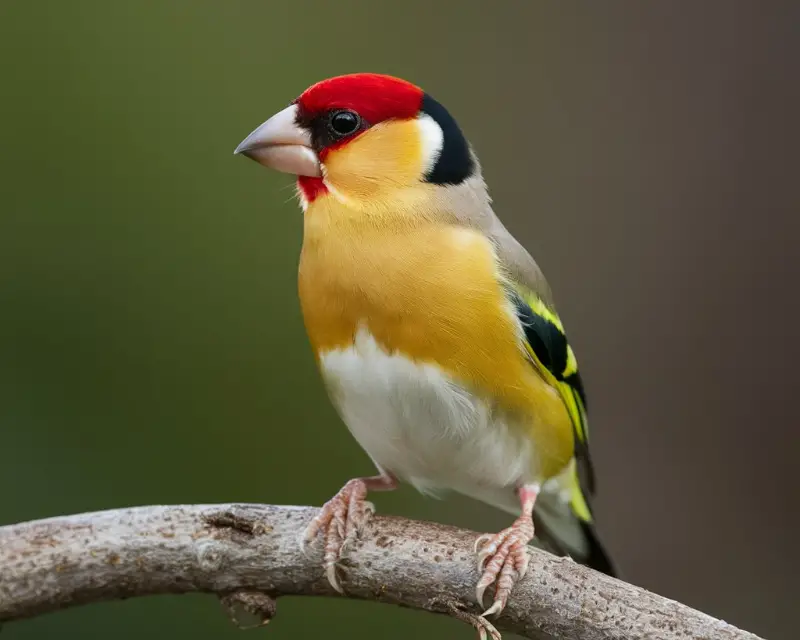
Comments are closed